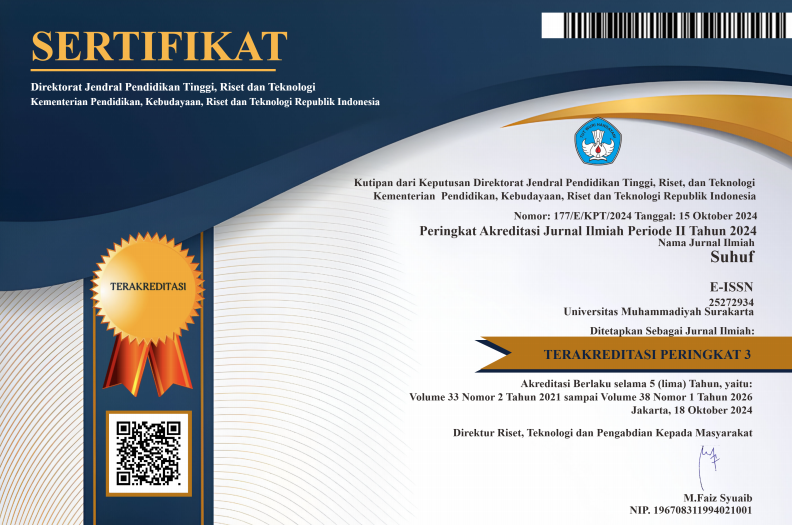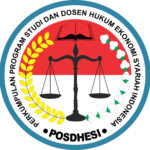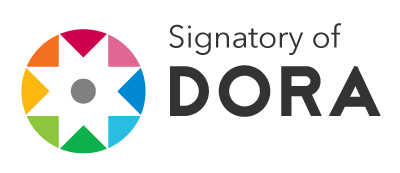Sharia Financial Literacy in the Digital Era: The Role of the Younger Generation in Embracing the Transformation of Islamic Finance
DOI:
https://doi.org/10.23917/suhuf.v37i2.11170Keywords:
Financial applications, Digital banking, Financial technology, Digital era, Islamic financial literacyAbstract
The level of Islamic financial literacy among the younger generation remains relatively low, while digital transformation in the financial sector is developing rapidly. This situation then creates a gap between the ability to utilise technology and an adequate understanding of Islamic financial concepts. This study aims to systematically review the academic literature on Islamic financial literacy among the younger generation in the digital era, identifying opportunities, challenges, and strategies for improving literacy. The method used was a Systematic Literature Review (SLR) of 20 scientific articles published between 2018 and 2025, focusing on three main aspects: literacy level, utilization of digitalization, and challenges in disseminating Islamic financial education. The study results indicate that digitalization has significant potential to increase access and effectiveness of Islamic financial education through social media platforms, financial applications, and digital banking services. However, most educational content remains descriptive, lacks interactivity, and is not fully aligned with the characteristics of the younger generation. Therefore, a collaborative strategy is needed between Islamic financial institutions, educational institutions, and other stakeholders to develop engaging, applicable, and sustainable Islamic financial literacy content. This research offers important implications for developing a more innovative and relevant Islamic financial education model tailored to the needs of the younger generation in the digital era.
Downloads
References
[1] T. N. Fitria, “Islamic Banking Digitalization: Challenges and Opportunities in the Era of Industrial Revolution 4.0,” JIEI J. Ilm. Ekon. Islam, vol. 11, no. 1, pp. 1–19, 2025, doi: https://doi.org/10.29040/jiei.v11i1.16855.
[2] U. Ahmed, A. Maruf, S. Alam, and L. Azizah, “The Role of Islamic Finance in Sustainable and Green Transition,” Suhuf, vol. 36, no. 2, Nov. 2024, doi: https://www.doi.org/10.23917/suhuf.v36i2.6314.
[3] A. Abubakar Muhammad, A. Ibrahim, A. A. Yakub, H. Khan, and N. Hamzah, “The Role of Islamic Finance in Promoting Economic Justice and Financial Inclusion among Marginalised Communities,” Suhuf Int. J. Islam. Stud., vol. 37, no. 1 SE-Articles, pp. 58–68, May 2025, doi: https://www.doi.org/10.23917/suhuf.v37i1.10167.
[4] L. S. S. Lau and R. Faridah, “Analysis of Islamic Financial Literacy of the Millenial Muslim Generation Regarding Islamic Fintech (Case Studies in Several …,” in Antasari Conference on Islamic …, 2024, pp. 25–38. [Online]. Available: https://jurnal.uin-antasari.ac.id/index.php/acieb/article/download/13995/4057
[5] S. Putri and R. Safitri, “The Influence of Digital Sharia Banking Services on the Digital Financial Literacy of Generation Z in Malang City,” AL-AFKAR J. Islam. Stud., vol. 8, no. 1, pp. 11–24, 2025, doi: https://doi.org/10.31943/afkarjournal.v8i1.1262
[6] N. C. Sunaryo, “Digital Indonesia Report 2024,” 2024. [Online]. Available: https://www.slideshare.net/slideshow/digital-indonesia-report-2024-by-we-are-social-pdf/267156491?from_search=2#3
[7] W. Suhasti, M. Muhamad, R. Penggalih, L. Febry Handayani, and A. Priyo Nugroho, “The Influence of Islamic Financial Literacy on The Use of Digital Financial Services in Yogyakarta,” in The 3rd International Conference on Advance & Scientific Innovation (ICASI), Jul. 2022, pp. 50–55. doi: https://doi.org/10.18502/kss.v7i10.11343.
[8] I. Tlemsani, A. Zaman, M. A. Mohamed Hashim, and R. Matthews, “Digitalization and sustainable development goals in emerging Islamic economies,” J. Islam. Account. Bus. Res., vol. 16, no. 5, pp. 890–914, May 2025, doi: https://doi.org/10.1108/JIABR-03-2023-0092.
[9] Z. Nkosinkulu, “Visualizing education: infographics and pop-up edutainment exhibitions,” J. Vis. Lit., vol. 43, no. 3, pp. 250–265, Jul. 2024, doi: https://doi.org/10.1080/1051144X.2024.2396253.
[10] D. Utari, D. Susetyo, and A. Maulana, “The Influence of Visual Content on Social Media on Generation Z Purchasing Decisions with Brand Engagement as an Intervening Variable,” J. Int. Conf. Proc., vol. 7, no. 5, pp. 1129–1143, Feb. 2025, doi: https://doi.org/10.32535/jicp.v7i5.3638.
[11] M. A. F. Awwal, “The Influence of Islamic Financial Literacy on Investment Decisions of the Millennial Generation,” J. Econ. Manag. Account., vol. 1, no. 1 SE-Articles, pp. 57–68, Jul. 2025, doi: https://doi.org/10.65310/dfwety56.
[12] E. S. Utaminingsih, I. Idammatussilmi, B. Y. Intania, and K. Kristiyuana, “An Interactive Qur’anic Values-Based Affective-Learning Approach to Mitigating School Bullying,” Suhuf, vol. 37, no. 1, pp. 237–249, May 2025, doi: https://www.doi.org/10.23917/suhuf.v37i1.10637.
[13] M. J. Page et al., “The PRISMA 2020 statement: an updated guideline for reporting systematic reviews,” BMJ, p. n71, Mar. 2021, doi: https://doi.org/10.1136/bmj.n71.
[14] A. Liberati et al., “The PRISMA Statement for Reporting Systematic Reviews and Meta-Analyses of Studies That Evaluate Health Care Interventions: Explanation and Elaboration,” PLoS Med., vol. 6, no. 7, p. e1000100, Jul. 2009, doi: https://doi.org/10.1371/journal.pmed.1000100.
[15] Andrean Dzulhijrah, Diana Nur’azzah, Milasiti Nursadiyah, M. Zaky Khaerul Rijal, Zahwa Nur Hasya, and Welsi Damayanti, “Analisis Tingkat Literasi Keuangan Syariah Mahasiswa Generasi Z,” J. Inov. Ekon. Syariah dan Akunt., vol. 2, no. 3 SE-Articles, pp. 128–144, (Indonesia), May 2025, doi: https://doi.org/10.61132/jiesa.v2i3.1008.
[16] N. Aqhzira Aulia Muhtar, Lismawati, “Adz Dzahab SHARIA FINANCIAL LITERACY OF GENERATION Z TOWARD Adz Dzahab,” J. Ekon. dan Bisnis Islam, vol. 10, no. 1, pp. 1–10, 2025, doi: https://doi.org/10.47435/adz-dzahab.v10i1.3496.
[17] Muhammad Raihan Aulia Firdausi and Rahmatina Awaliah Kasri, “Islamic Financial Literacy Amongst Muslim Students in Indonesia: A Multidimensional Approach,” AL-MUZARA’AH, pp. 77–94, Mar. 2022, doi: https://doi.org/10.29244/jam.specialissue2022.77-94.
[18] D. Patrisia, A. Abror, S. Dastgir, and R. Rahayu, “Generation Z’s Financial Behaviour: The Role of Islamic Financial Literacy,” ISRA Int. J. Islam. Financ., vol. 15, no. 2, pp. 20–37, May 2023, doi: https://doi.org/10.55188/ijif.v15i2.540.
[19] D. Sugiarti, “Literasi Keuangan Syariah Generasi Z dan Minatnya pada Perbankan Syariah (Studi Kasus pada Siswa SMK di Jakarta),” J. Ilm. Ekon. Islam, vol. 9, no. 1 SE-Articles, pp. 766–772, (Indonesia), Mar. 2023, doi: https://doi.org/10.29040/jiei.v9i1.7991.
[20] M. Herawati and M. Mukhsin, “Islamic Financial Literacy In Digital Age: The Role Of Social Capital And Digital Literacy,” Al-Intaj J. Ekon. dan Perbank. Syariah, vol. 11, no. 1, p. 111, Mar. 2025, doi: http://dx.doi.org/10.29300/aij.v11i1.7074.
[21] A. Azra Rosadi, C. Alexakis, and A. Pratiwi Putri, “ENHANCING ISLAMIC FINANCIAL LITERACY IN INDONESIAN YOUTH GENERATES BROADER SOCIETAL BENEFITS,” PEOPLE Int. J. Soc. Sci., vol. 10, no. 1, pp. 13–26, Mar. 2024, doi: https://doi.org/10.20319/pijss.2024.101.1326.
[22] D. Pranatasari, D. N. A. Rahmanto, and R. S. Wicaksana, “Digital Islamic Financial Literacy and Inclusion on Profitability of Micro, Small and Medium Enterprises,” Nusant. Islam. Econ. J., vol. 1, no. 1, pp. 40–53, Dec. 2021, doi: https://doi.org/10.34001/nuiej.v1i1.56.
[23] I. Alfian and M. S. Abd Majid, “The Role of Sharia Fintech in Enhancing Financial Inclusion in the Digital Era,” J. Financ. Islam. Bank., vol. 8, no. 1, pp. 79–94, 2025, doi: https://doi.org/10.22515/jfib.v8i1.11798.
[24] A. Nurkholik, “Trends in Digital Financial Literacy Research on the Indonesian Millennial Generation: A Systematic Literature Review,” RSF Conf. Ser. Business, Manag. Soc. Sci., vol. 3, no. 3, pp. 253–263, Sep. 2023, doi: https://doi.org/10.31098/bmss.v3i3.670.
[25] A. Y. Pradini and A. Faozan, “SHARIA FINANCIAL LITERACY AND INCLUSION: OPPORTUNITIES AND CHALLENGES,” Al-Mustashfa J. Penelit. Huk. Ekon. Syariah, vol. 8, no. 2, p. 205, Dec. 2023, doi: http://dx.doi.org/10.24235/jm.v8i2.15406.
[26] Z. A. Siregar, N. Nurbaiti, and M. Syahbudi, “Influence Literacy Finance Shariah and Use Syariah Fintech Lending on the Development of MSMEs,” J. Appl. Bus. Adm., vol. 9, no. 1 SE-Articles, pp. 71–83, Mar. 2025, doi: https://doi.org/10.30871/jaba.v9i1.9267.
[27] S. N. Amani, Woro Nilam Lestari, and Yeni Nurjanah, “Accommodating Digital Transformation in Sharia Financing of Sharia Financial Institutions: Indonesian Case,” J. Econ. Stud., vol. 7, no. 2 SE-Articles, pp. 62–76, Dec. 2023, doi: https://doi.org/10.32506/joes.v7i2.854.
[28] A. M. Putri, S. K. Wiryono, S. M. Damayanti, and R. A. Rahadi, “Digital Financial Literacy Challenges and Issues: Case in Indonesia,” J. Econ. Bus., vol. 7, no. 4, Dec. 2024, doi: https://doi.org/10.31014/aior.1992.07.04.643.
[29] N. W. AL, R. T. Mangesa, A. Arfandi, S. Supriadi, and A. M. Mappalotteng, “Efektivitas Penerapan Model Project Based Learning Terhadap Motivasi dan Kemampuan Pemahaman Konsep Siswa Sekolah Menengah Kejuruan [Effectiveness of Project-Based Learning in Enhancing Motivation and Conceptual Understanding among Vocational High School ,” UNM J. Technol. Vocat., vol. 7, no. 1, pp. 45–57, (Indonesia), 2023, doi: https://doi.org/10.26858/ujtv.v7i1.38183.
Downloads
Submitted
Accepted
Published
How to Cite
Issue
Section
License
Copyright (c) 2025 Fauzia Kamila Hayati, Ruspita Rani Pertiwi

This work is licensed under a Creative Commons Attribution 4.0 International License.


















